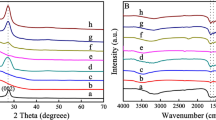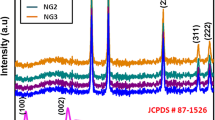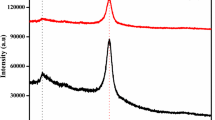Abstract
The composite g-C3N4-TiO2 was successfully synthesized by sol–gel method and fixed on carbon felt to obtain g-C3N4-TiO2/CF, which was used as the anode of photocatalytic fuel cell for efficient degradation of tetracycline and power generation. The results of SEM, EDS, XRD, FT-IR and XPS imply that the g-C3N4-TiO2/CF has been prepared successfully. The g-C3N4-TiO2/CF has more advantages in structure, photocatalytic activity and photoelectric properties, which are proved by UV–Vis, PL, photocurrent spectral, OCP and Mott–Schottky plots. As expected, the g-C3N4-TiO2/CF exhibited a prominent degradation efficiency of 98.3% in the photocatalytic performance of tetracycline hydrochloride (TC) under 100 W LED. The dual-chamber fuel cell was constructed with g-C3N4-TiO2/CF as the photocatalytic anode, and the initial voltage of the cell reached 90 mV. The degradation pathway of TC is also proposed.

















Similar content being viewed by others

Data availability
All data generated or analyzed during this study are included in this published article.
Abbreviations
- CF:
-
Carbon felt
- DRS:
-
Diffuse reflectance spectroscopy
- EDS:
-
Energy dispersive spectrometer
- FT-IR:
-
Fourier transform infrared
- HPLC:
-
High-performance liquid chromatography
- LED:
-
Light-emitting diode
- OCP:
-
Open circuit potential
- SEM:
-
Scanning electron microscopy
- BET:
-
Brunauer–Emmet–Teller
- TC:
-
Tetracycline hydrochloride
- UV:
-
Ultraviolet
- UV–Vis:
-
Ultraviolet–visible
- PL:
-
Photoluminescence
- XPS:
-
X-ray photoelectron spectroscopy
- XRD:
-
X-ray diffraction
- LC-MS:
-
Liquid chromatography–mass spectrometry
- PFC:
-
photocatalytic fuel cell
References
H. Jing, R. Ou, H. Yu et al., Engineering of g-C3N4 nanoparticles/WO3 hollow microspheres photocatalyst with Z-scheme heterostructure for boosting tetracycline hydrochloride degradation. Sep. Purif. Technol. 255, 117646 (2021)
X. Zhao, X. Li, X. Zhang et al., Bioelectrochemical removal of tetracycline from four typical soils in China: a performance assessment. Bioelectrochemistry 129, 26–33 (2019)
J. Cheng, D. Wang, B. Wang et al., Plasma-catalytic degradation of ciprofloxacin in aqueous solution over different MnO2 nanocrystals in a dielectric barrier discharge system. Chemosphere 253, 126595 (2020)
N. Mahendran, K. Praveen, BiPO4/Fe-metal organic framework composite: a promising photocatalyst toward the abatement of tetracycline hydrochloride, Indigo Carmine and reduction of 4-nitrophenol. J. Ind. Eng. Chem. 100, 220–232 (2021)
Z. Yang, Z. Zhao, X. Yang et al., Xanthate modified magnetic activated carbon for efficient removal of cationic dyes and tetracycline hydrochloride from aqueous solutions. Colloids Surf. A 615, 126273 (2021)
D. Zhang, Q. He, X. Hu et al., Enhanced adsorption for the removal of tetracycline hydrochloride (TC) using ball-milled biochar derived from crayfish shell. Colloids Surf. A 615, 126254 (2021)
Z. Zhang, Y. Chen, Z. Wang et al., Effective and structure-controlled adsorption of tetracycline hydrochloride from aqueous solution by using Fe-based metal-organic frameworks. Appl. Surf. Sci. 542, 148662 (2021)
X. Peng, J. Cao, B. Xie et al., Evaluation of degradation behavior over tetracycline hydrochloride by microbial electrochemical technology: performance, kinetics, and microbial communities. Ecotoxicol. Environ. Saf. 188, 109869 (2020)
X. Yu, X. Huang, Y. Huang et al., Crystal phase transition of β-Bi2O3 and its enhanced photocatalytic activities for tetracycline hydrochloride. Colloids Surf. A 626, 127068 (2021)
F. Li, X. Lan, L. Wang et al., An efficient photocatalyst coating strategy for intimately coupled photocatalysis and biodegradation (ICPB): powder spraying method. Chem. Eng. J. 383, 123092 (2020)
C. Lv, X. Lan, L. Wang et al., Rapidly and highly efficient degradation of tetracycline hydrochloride in wastewater by 3D IO-TiO2-CdS nanocomposite under visible light. Environ. Technol. 42(3), 377–387 (2021)
G. Zhang, G. Huang, C. Yang et al., Efficient photoelectrocatalytic degradation of tylosin on TiO2 nanotube arrays with tunable phosphorus dopants. J. Environ. Chem. Eng. 9(1), 104742 (2021)
L. Shao, S. Cheng, Z. Yang et al., Nickel aluminum layered double hydroxide nanosheets grown on oxygen vacancy-rich TiO2 nanobelts for enhanced photodegradation of an antibiotic. J. Photochem. Photobiol. A 411, 113209 (2021)
Z. Wei, J. Liu, W. Shangguan, A review on photocatalysis in antibiotic wastewater: pollutant degradation and hydrogen production. Chin. J. Catal. 41(10), 1440–1450 (2020)
J.L. Shi, X. Lang, Assembling polydopamine on TiO2 for visible light photocatalytic selective oxidation of sulfides with aerial O2. Chem. Eng. J. 392, 123632 (2020)
C.B. Ozkal, S. Meric, Photocatalytic bacteria inactivation by TiO2-Ag based photocatalysts and the effect on antibiotic resistance profile. Curr. Anal. Chem. 17(1), 98–106 (2021)
Y. Miao, X. Xu, K. Liu et al., Preparation and activity evaluation of the novel Cu/TiO2 nanometer photocatalytic materials. Sci. Adv. Mater. 12(7), 1027–1033 (2020)
X. Huang, W. Yang, G. Zhang et al., Alternative synthesis of nitrogen and carbon co-doped TiO2 for removing fluoroquinolone antibiotics in water under visible light. Catal. Today 361, 11–16 (2021)
D. Selishchev, D. Svintsitskiy, L. Kovtunova et al., Surface modification of TiO2 with Pd nanoparticles for enhanced photocatalytic oxidation of benzene micropollutants. Colloids Surf. A 612, 125959 (2021)
U. Baig, M.K. Uddin, M. Sajid, Surface modification of TiO2 nanoparticles using conducting polymer coating: spectroscopic, structural, morphological characterization and interaction with dye molecules. Mater. Today Commun. 25, 101534 (2020)
H. Luo, S. Yu, F. He et al., An important phenomenon in Fe2O3-TiO2 photocatalyst: Ion-inter-doping. Solid State Sci. 113, 106538 (2021)
N. Iqbal, A. Afzal, I. Khan et al., Molybdenum impregnated g-C3N4 nanotubes as potentially active photocatalyst for renewable energy applications. Sci. Rep. 11(1), 1–12 (2021)
H. Zhang, G. Zhang, H. Zhang et al., Facile synthesis hierarchical porous structure anatase–rutile TiO2/g-C3N4 composite for efficient photodegradation tetracycline hydrochloride. Appl. Surf. Sci. 567, 150833 (2021)
A. Evidente, A. Kornienko, Anticancer evaluation of structurally diverse Amaryllidaceae alkaloids and their synthetic derivatives. Phytochem. Rev. 8(2), 449–459 (2009)
A.R. Kuldeep, R.S. Dhabbe, K.M. Garadkar, Development of g-C3N4-TiO2 visible active hybrid photocatalyst for the photodegradation of methyl orange. Res. Chem. Intermed. 47(12), 5155–5174 (2021)
P. Parnicka, P. Mazierski, W. Lisowski et al., A new simple approach to prepare rare-earth metals-modified TiO2 nanotube arrays photoactive under visible light: Surface properties and mechanism investigation. Results Phys. 12, 412–423 (2019)
A. Kane, L. Chafiq, S. Dalhatou et al., g-C3N4/TiO2 S-scheme heterojunction photocatalyst with enhanced photocatalytic Carbamazepine degradation and mineralization. J. Photochem. Photobiol. A 430, 113971 (2022)
L. Ghalamchi, S. Aber, V. Vatanpour et al., A novel antibacterial mixed matrixed PES membrane fabricated from embedding aminated Ag3PO4/g-C3N4 nanocomposite for use in the membrane bioreactor. J. Ind. Eng. Chem. 70, 412–426 (2019)
A. Naseri, M. Samadi, A. Pourjavadi et al., Enhanced photocatalytic activity of ZnO/g-C3N4 nanofibers constituting carbonaceous species under simulated sunlight for organic dye removal. Ceram. Int. 47, 26185 (2021)
C. Lazau, M. Poienar, C. Orha et al., Development of a new “np” heterojunction based on TiO2 and CuMnO2 synergy materials. Mater. Chem. Phys. 272, 124999 (2021)
X. Du, X. Bai, L. Xu et al., Visible-light activation of persulfate by TiO2/g-C3N4 photocatalyst toward efficient degradation of micropollutants. Chem. Eng. J. 384, 123245 (2020)
A. Toghan, H.M. Abd El-Lateef, K. Taha et al., Mesoporous TiO2@ g-C3N4 composite: construction, characterization, and boosting indigo carmine dye destruction. Diam. Relat. Mater. 118, 108491 (2021)
K.J. Tian, H. Liu, Y.P. Dong et al., Amperometric detection of glucose based on immobilizing glucose oxidase on g-C3N4 nanosheets. Colloids Surf. A 581, 123808 (2019)
C. Wang, Y. Dai, X. Fu et al., A novel layer-layer crossed structure of bentonite/g-C3N4 for enhanced photocatalytic oxidation of arsenic (III) in a wide pH range. Surf. Interfaces 26, 101365 (2021)
X.T. Zhou, X.H. Liu, X.J. Huang et al., TiO2 nanotube arrays sensitized by copper (II) porphyrins with efficient interfacial charge transfer for the photocatalytic degradation of 4-nitrophenol. J. Hazard. Mater. 422, 126869 (2022)
H. Sun, Y. Guo, O.A. Zelekew et al., Biological renewable nanocellulose templated CeO2/TiO2 synthesis and its photocatalytic removal efficiency of pollutants. J. Mol. Liq. 336, 116873 (2021)
X. Wang, H. Xu, X. Luo et al., Enhanced photocatalytic properties of CeO2/TiO2 heterostructures for phenol degradation. Colloid Interface Sci. Commun. 44, 100476 (2021)
J. Wang, G. Wang, X. Wang et al., 3D/2D direct Z-scheme heterojunctions of hierarchical TiO2 microflowers/g-C3N4 nanosheets with enhanced charge carrier separation for photocatalytic H2 evolution. Carbon 149, 618–626 (2019)
A.B. Dehkordi, A. Ziarati, J.B. Ghasemi et al., Preparation of hierarchical g-C3N4@TiO2 hollow spheres for enhanced visible-light induced catalytic CO2 reduction. Sol. Energy 205, 465–473 (2020)
M.S. Nasir, G. Yang, I. Ayub et al., Tin diselinide a stable co-catalyst coupled with branched TiO2 fiber and g-C3N4 quantum dots for photocatalytic hydrogen evolution. Appl. Catal. B 270, 118900 (2020)
B. Zhang, X. He, X. Ma et al., In situ synthesis of ultrafine TiO2 nanoparticles modified g-C3N4 heterojunction photocatalyst with enhanced photocatalytic activity. Sep. Purif. Technol. 247, 116932 (2020)
S. Pourhashem, J. Duan, F. Guan et al., New effects of TiO2 nanotube/g-C3N4 hybrids on the corrosion protection performance of epoxy coatings. J. Mol. Liq. 317, 114214 (2020)
Z. Cao, J. Su, Y. Li et al., High-energy ball milling assisted one-step preparation of g-C3N4/TiO2@ Ti3C2 composites for effective visible light degradation of pollutants. J. Alloys Compds. 889, 161771 (2022)
M.H. Barzegar, M. Sabzehmeidani, M. Ghaedi et al., S-scheme heterojunction g-C3N4/TiO2 with enhanced photocatalytic activity for degradation of a binary mixture of cationic dyes using solar parabolic trough reactor. Chem. Eng. Res. Des. 174, 307–318 (2021)
Z. Li, G. Jiang, Z. Zhang et al., Phosphorus-doped g-C3N4 nanosheets coated with square flake-like TiO2: Synthesis, characterization and photocatalytic performance in visible light. J. Mol. Catal. A: Chem. 425, 340–348 (2016)
R. Rajendran, S. Vignesh, A. Sasireka et al., Designing Ag2O modified g-C3N4/TiO2 ternary nanocomposites for photocatalytic organic pollutants degradation performance under visible light: Synergistic mechanism insight. Colloids Surf. A 629, 127472 (2021)
Y. Liu, S. Wu, J. Liu et al., Synthesis of g-C3N4/TiO2 nanostructures for enhanced photocatalytic reduction of U (vi) in water. RSC Adv. 11(8), 4810–4817 (2021)
F. Qi, W. An, H. Wang et al., Combing oxygen vacancies on TiO2 nanorod arrays with g-C3N4 nanosheets for enhancing photoelectrochemical degradation of phenol. Mater. Sci. Semicond. Process. 109, 104954 (2020)
H. Zhu, X. Yang, M. Zhang et al., Construction of 2D/2D TiO2/g-C3N4 nanosheet heterostructures with improved photocatalytic activity. Mater. Res. Bull. 125, 110765 (2020)
X. Guo, J. Duan, C. Li et al., Fabrication of g-C3N4/TiO2 photocatalysts with a special bilayer structure for visible light photocatalytic application. Colloids Surf. A 599, 124931 (2020)
C. Ma, J. Wei, K. Jiang et al., Self-assembled micro-flowers of ultrathin Au/BiOCOOH nanosheets photocatalytic degradation of tetracycline hydrochloride and reduction of CO2. Chemosphere 283, 131228 (2021)
Q. Wang, P. Li, Z. Zhang et al., Kinetics and mechanism insights into the photodegradation of tetracycline hydrochloride and ofloxacin mixed antibiotics with the flower-like BiOCl/TiO2 heterojunction. J. Photochem. Photobiol. A 378, 114–124 (2019)
Z. Shi, Y. Zhang, X. Shen et al., Fabrication of g-C3N4/BiOBr heterojunctions on carbon fibers as weaveable photocatalyst for degrading tetracycline hydrochloride under visible light. Chem. Eng. J. 386, 124010 (2020)
B. Pandey, S. Rani, S.C. Roy, A scalable approach for functionalization of TiO2 nanotube arrays with g-C3N4 for enhanced photo-electrochemical performance. J. Alloys Compds. 846, 155881 (2020)
T. Wu, C. Chen, Y. Wei et al., Fluorine and tin co-doping synergistically improves the photoelectrochemical water oxidation performance of TiO2 nanorod arrays by enhancing the ultraviolet light conversion efficiency. Dalton Trans. 48(32), 12096–12104 (2019)
S. Vinoth, A. Pandikumar, Ni integrated S-gC3N4/BiOBr based Type-II heterojunction as a durable catalyst for photoelectrochemical water splitting. Renew. Energy 173, 507–519 (2021)
Acknowledgements
The authors acknowledge Ms. Xuan Wang for guidance and assistance.
Funding
This study was supported by the Project of the National Natural Science Foundation of China: Study on the degradation mechanism of antibiotic-containing wastewater by microbial fuel cell under visible light (No. 22065027) and the Natural Science Foundation of Inner Mongolia (No. 2019BS02013).
Author information
Authors and Affiliations
Contributions
YS and XW performed the data analyses and wrote the manuscript; WL and SZ performed the experiment; JC helped perform the analysis with constructive discussions; SK and JX contributed significantly to analysis and manuscript preparation.
Corresponding author
Ethics declarations
Competing interests
The authors declare that they have no competing interests.
Ethical approval
This article does not contain any studies with human participants or animals performed by any of the authors. In this experiment, we did not collect any samples of human and animals.
Additional information
Publisher's Note
Springer Nature remains neutral with regard to jurisdictional claims in published maps and institutional affiliations.
Supplementary Information
Below is the link to the electronic supplementary material.
Rights and permissions
Springer Nature or its licensor (e.g. a society or other partner) holds exclusive rights to this article under a publishing agreement with the author(s) or other rightsholder(s); author self-archiving of the accepted manuscript version of this article is solely governed by the terms of such publishing agreement and applicable law.
About this article
Cite this article
Shi, Y., Li, W., Zhang, S. et al. Titanium dioxide lamellae bearing graphitic carbon nitride fixed on carbon felt as the photoanode in a photocatalytic fuel cell for use in tetracycline degradation and electricity generation. J Mater Sci: Mater Electron 34, 227 (2023). https://doi.org/10.1007/s10854-022-09425-w
Received:
Accepted:
Published:
DOI: https://doi.org/10.1007/s10854-022-09425-w



